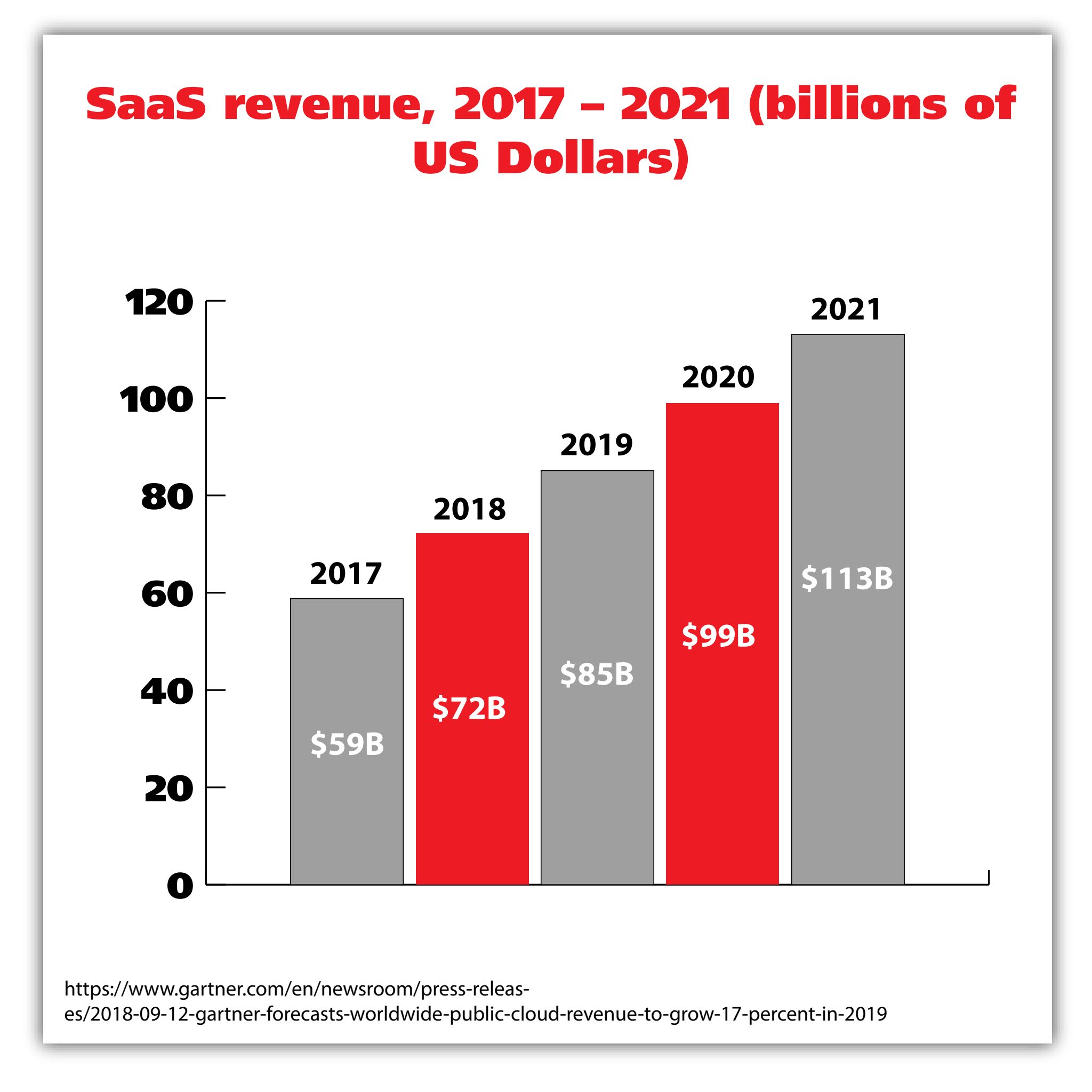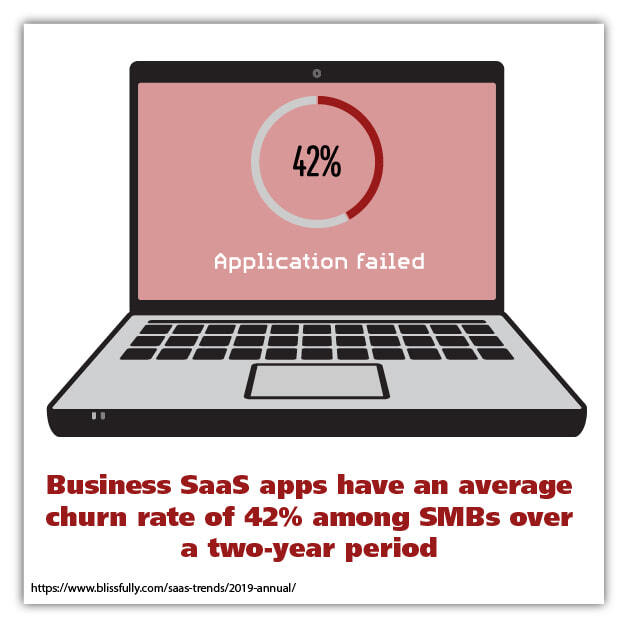What Is Software as a Service?
If you keep one eye on business technology, you may have noticed that Software as a Service (SaaS) has become a common factor across virtually every industry.
Software as a Service is a form of software deployment which means that applications and software are licensed through an on-going subscription and hosted on the cloud.
This differs from the more traditional ways of buying software, which would typically involve physically buying a software package and then installing and implementing it on-site.
SaaS has completely changed how businesses approach software, and organizations are migrating en masse to cloud SaaS apps.
Common examples of SaaS apps include:
- Microsoft 365
- Slack
- Dropbox
- Salesforce
- Google Suite
State of the Market
73% of organizations estimate that the overwhelming majority (80%) of their software apps will be SaaS by next year.
This is mostly in line with the upward trend of the SaaS industry which has been significantly growing in size since the late 2000s.
Worth $5.6 billion in 2008, the Software as a Service industry is forecast to grow to nearly $100 billion in 2020.
These trends are largely consistent with increased cloud use across the board, which has seen virtually all businesses from every industry adopt cloud services in one form or another.
The Benefits of SaaS
Implementation
Because SaaS apps are implemented through the cloud and require an internet connection to be accessed, several aspects of maintenance are made a lot easier with SaaS.
The primary aspect that is made simple is updating the software, which can be done as long as the device has internet access.
With legacy systems, updates have to made directly to the machine, creating an additional layer of work to maintaining your apps.
There is also the fact that SaaS apps largely operate via accounts, as opposed to particular designated machines.
This means that all you need is to be logged into the account and you’ll have access to the software, regardless of your location or the device you’re using.
This is one of the main reasons “bring your own device” (BYOD) policies and remote work opportunities have become so common place.
Cost Efficiency
One of the biggest reasons for adopting SaaS solutions is the reduction in expenses they can bring to a business.
SaaS usually operates on a per-per-user model, meaning you only need to purchase licenses for the people who are going to use it.
Legacy systems, by contrast, require you to have the hardware capabilities of running the software, which can be a major sticking point, especially for smaller SMBs.
Because SaaS models typically function with a monthly or yearly subscription, there is a lot more wiggle room than what is afforded by traditional software licensing.
The days of paying exorbitant upfront fees are rapidly disappearing with the popularity of SaaS.
Scalability
Last, but not least, is scalability. With SaaS, there is not only no need to buy hardware, but also no need to buy additional hardware.
For example, if you use an SaaS app and need more server capacity or uses, you simply adjust the subscription and they handle the hardware on their end.
By extension, the provider also responsible for other important aspects of management so the client doesn’t have to be—namely physical upgrades, uptime, and security.
In the event of increased or decreased use by an organization, the provider will scale what you use accordingly so you’re not paying for anything you don’t need.
Managed Service Providers
At this point, you might be wondering what managed service providers (MSPs) have to do with any of this.
If SaaS is so easy to implement and maintain, why does any organization need additional help?
Why not just do it yourself?
MSPs have been rising in popularity over the last few years, and the industry is seeing massive growth.
The adoption of managed services is being driven for a lot of the same reasons that businesses are adopting SaaS solutions—they’re affordable, scalable, and bring efficiencies across the board for an organization.
An estimated 75% of SMBs outsource at least some of the IT capabilities to MSPs.
The key word here is “managed”—an MSP does all the heavy lifting so you don’t have to.
The Problems Faced by SMBs With SaaS Solutions
Blissfully’s annual SaaS trends report for 2019 found that the average company with 200 to 500 employees uses about 123 SaaS applications.
This, of course, means that there’s a lot of software to manage, which is a job in itself.
SMBs often find that their software stack, sometimes cobbled together by different departments all across the company, can be messy and unruly.
This has led to many companies experiencing unsatisfactory issues with their SaaS apps. These issues include:
Rapidly changing stacks
Unlike MSPs, which spend years vetting and perfecting the software stacks they offer customers, decision makers of SMBs don’t have the same level of expertise needed to build a ready-to-go stack. The result of this is a lot of trial and error. The average company has a 2-year app turnover rate of 42%—often because it’s too expensive or not serving their needs adequately.
Chopping and changing solutions is expensive, stressful, and time-consuming.
“Orphaned” solutions
An orphaned solution is when a subscription has no billing owner. This is typically because the owner has left the company and the offboarding process hasn’t accounted for solutions under their name.
A staggering 71% of businesses have orphaned subscriptions, each having three on average. If you have orphaned solutions, then you’re effectively carrying dead weight in your organization.
Duplicate subscriptions
By 2020, a quarter of all IT spend will be dedicated to software applications. There’s little room for businesses to lose out by spending double on duplicate apps because of mismanagement.
30% of software licenses costs are wasted because of poor management leading to occurrences like subscription duplications.
Different billing owners
Midsize organizations have an average of 32 different billing owners for their SaaS subscriptions.
This is obviously a big issue in terms of management—it makes it a lot harder to determine who is responsible for each app and increases the likelihood of dupes and orphaned solutions.
How Does a Managed Service Provider Help With SaaS?
In short, as useful as the cloud revolution for software services has been, it also throws up a mountain of obstacles for SMBs.
This is why many SMBs are seeking the support of MSPs for their technology needs.
If your SaaS is taken care of by your MSP partner, you can expect:
Single point of contact
One of the main benefits with an MSP as your partner is that they act as your point of contact for anything related to your IT. A quality partner will have a strong record for resolution and availability.
At Impact, for example, all our help desk staff are internal, meaning we hold ourselves fully accountable to our clients. We recommend partnering with an MSP that keeps all their processes in-house.
Upgrades and management
You will find with a good MSP that you are assigned a vCIO, who is a technology expert responsible for guiding your projects based on your needs and maintaining your goals and vision.
In layman’s, you’ll have someone who makes sure everything is running like clockwork—no duplicates, outdated software, or solutions that are unnecessary.
More transparency
As we looked at earlier, one of the main issues with handling many SaaS services is getting a clear insight into every solution you use.
A managed service provider gives you access to experts in every field of technology, so you are recommended the best tech stacks tailored for you. You can also be assured that with a good MSP those solutions have been vetted and tested over several years and determined to be the best for the job.
Simpler
Partnering with an MSP frankly makes SaaS a whole lot simpler. Fees are outlined and predictable and your partner will take care of tasks like server allocation, so you’re never paying for services you don’t need.
Takeaways
- SaaS is now the dominant form of software delivery
- Businesses often find themselves struggling with the number of apps they now have to manage
- MSPs have unparalleled access to the expertise and tools necessary for implementing a strong plan for your SaaS
Thinking it’s time to talk to someone about your company’s IT? Reach out to Impact’s Managed IT team and speak to one of our experts today!


